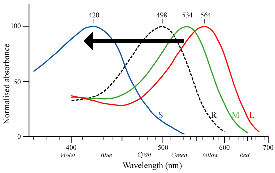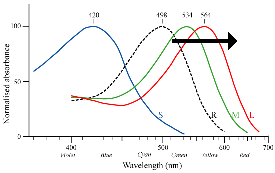|
Color blindness is a misleading term that is used to describe a wide range of color deficiencies. Complete color blindness is extremely rare. Color deficiencies can usually be attributed to genetics, but it is also possible to acquire them through eye, nerve, or brain damage. About 10% of American males are "color blind" in varying types and degrees, and I am one of them! Some individuals can go their whole lives without realizing they are color blind, depending on the type and severity of their condition. The different types of color blindness can first be divided into the following categories: red-green color blindness, blue-yellow color blindness, and monochromacy (complete color blindness). Red-green is the most common form of color blindness. Blue-yellow color blindness is rare and distributed equally among males and females. Monochromacy is extremely rare except in certain isolated societies (such as the island of Pohnpei). But these are all biological issues that you will have to look into on your own time! Blue-yellow color blindness is caused by inactivation of the short-wavelength cone cells. Monochromacy has two causes. If a person only has one functioning set of cone cells, they will be completely color blind. If a person has no functioning sets of cone cells, their vision relies entirely upon their rod cells, which also makes them completely color blind. Red-green color blindness can be divided into the following categories:
Below are two examples of the Ishihara test for color blindness. Individuals with normal color vision should see a number formed out of the dots. Individuals who are red-green color blind will only see a circle of dots with nothing inside. These tests are not foolproof, however, because even the different types of color blindness can afflict people in varying degrees (corresponding to the number of cone cells missing in the cases of protanopia or deuteranopia, or the degree to which a sensitivity distribution is shifted in the cases of protanomaly and deuteranomaly). I chose these two Ishihara test examples specifically because I don't see anything inside of them.   Both pictures from: http://www.toledo-bend.com/colorblind/Ishihara.html | |
| << Color Vision | Color Blindness in Day-to-Day Life >> |

